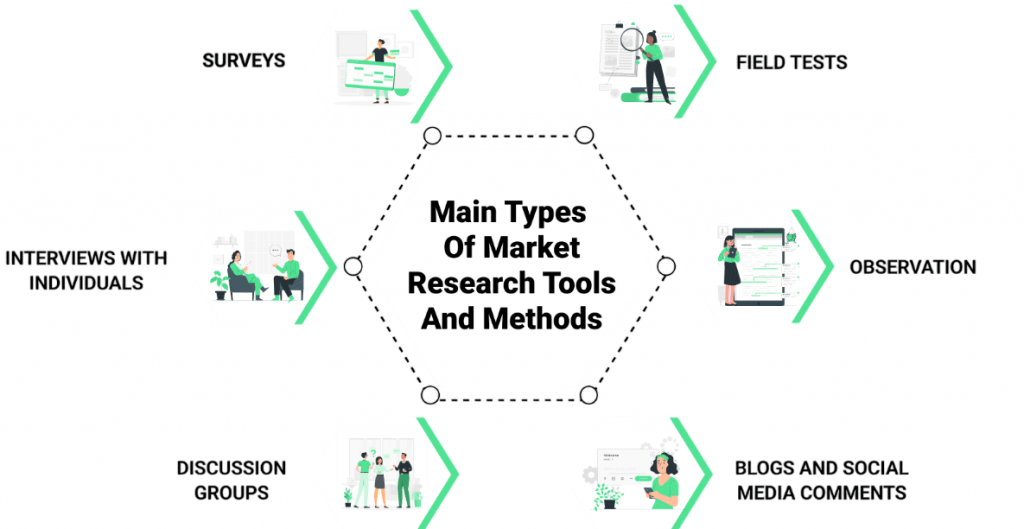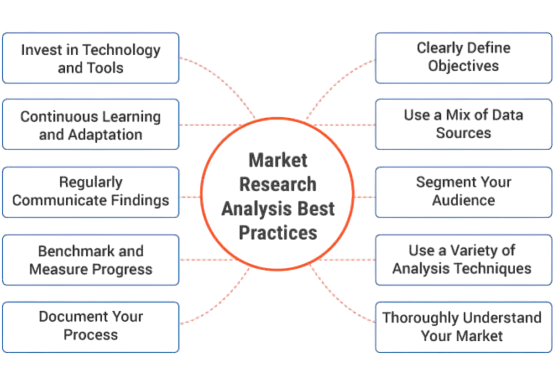
- What is Market Research?
- Types: Primary vs Secondary
- Quantitative vs Qualitative Research
- Research Methods (Surveys, Interviews)
- Identifying Market Trends
- Competitor Analysis
- Understanding Customer Needs
- Tools and Software
- Data Collection Best Practices
- Analyzing and Interpreting Data
- How to Present Research Findings
- Common Mistakes to Avoid
- Conclusion
What is Market Research?
Market research is the systematic process of gathering, analyzing, and interpreting information about a market, including information about potential customers and competitors. It helps businesses understand market dynamics, customer preferences, buying behavior, and the overall environment in which they operate core analytical capabilities developed through Digital Marketing Training, where learners master data interpretation, audience segmentation, and strategic planning to thrive in competitive digital ecosystems. Through market research, organizations can make informed decisions, reduce risks, and create strategies to achieve competitive advantages. Whether launching a new product, entering a new market, or optimizing a marketing campaign, market research provides the insights necessary for success.
Ready to Get Certified in Digital Marketing? Explore the Program Now Digital Marketing Online Training Offered By ACTE Right Now!
Types: Primary vs Secondary Research
Market research is broadly classified into two categories, primary and secondary. Primary research involves collecting data directly from the source through methods like surveys, interviews, and focus groups. This data is specific, current, and tailored to the research objectives data-driven precision emphasized in What Is Digital Business, where professionals explore how targeted keyword research, audience segmentation, and analytics alignment empower digital strategies that meet evolving market demands and deliver measurable outcomes. Secondary research, on the other hand, involves analyzing data that already exists such as industry reports, academic journals, and statistical databases. While primary research offers direct insights, secondary research provides context and saves time and cost. Often, businesses use a mix of both to gain a well-rounded perspective.
Quantitative vs Qualitative Research
- Quantitative research focuses on numbers and statistical analysis. It answers the “what,” “when,” and “how many” questions using tools like online surveys, polls, and questionnaires.
- Qualitative research, in contrast, explores the “why” and “how” through in-depth methods like interviews, focus groups, and observation. It provides deeper insights into consumer motivations, emotions, and behaviors. Combining Quantitative vs Qualitative Research types of research allows businesses to validate hypotheses with data.
- Surveys and interviews are two of the most common methods used in market research methods. Surveys use structured questionnaires to gather large amounts of data quickly. They can be administered online, over the phone, or in person.
- Interviews are typically more qualitative, allowing for in-depth exploration of a respondent’s thoughts and experiences. Other methods include focus groups, which involve guided discussions with a small group of participants.
- Observational research, which studies customer behavior in real-world settings. Choosing the right research methods depends on the research objectives, target audience, and budget.
- Understanding customer needs is at the heart of effective market research. This involves identifying what customers value, their preferences, pain points, and decision-making processes. Businesses use tools like customer personas, journey maps, and satisfaction surveys to capture these insights.
- Meeting customer needs leads to higher satisfaction, loyalty, and brand advocacy. Listening to customers through feedback channels, social media, and CRM systems enables continuous improvement in products and services.
- Effective data collection requires a structured approach and adherence to best practices. First, clearly define research objectives and target audience. Choose the appropriate data collection method and design unbiased, easy-to-understand questions.
- Pilot test surveys to ensure clarity and effectiveness. Ensure data privacy and obtain informed consent from participants. Regularly monitor data quality and completeness during collection. Proper training of data collectors and use of digital tools enhances efficiency and accuracy.
- Presenting research findings effectively is crucial for stakeholder buy-in and action. Start with a clear executive summary highlighting key insights and recommendations. Use visuals such as charts, infographics, and dashboards to make data accessible and engaging.
- Organize findings logically, aligning them with the research objectives. Tailor the presentation style and depth based on the audience’s interests and knowledge level. Encourage questions and discussions to validate interpretations and explore implications. A well-structured presentation can turn insights into impactful strategies an approach emphasized in Content Marketing Strategy, where marketers learn to translate data into compelling narratives, structure insights for clarity, and foster engagement through interactive delivery. This ensures that content not only informs but drives strategic action.
To Explore Digital Marketing in Depth, Check Out Our Comprehensive Digital Marketing Online Training To Gain Insights From Our Experts!
Research Methods (Surveys, Interviews)

Identifying Market Trends
Identifying market trends involves analyzing changes and patterns in consumer behavior, industry developments, technological advancements, and economic shifts. By studying market trends, businesses can anticipate future demands, adapt their strategies, and stay ahead of the competition skills sharpened through Digital Marketing Training, where learners decode consumer behavior, forecast shifts, and build agile campaigns that respond to evolving market signals. Trend analysis often uses historical data, expert opinions, and consumer sentiment analysis. Emerging trends such as sustainability, digital transformation, and personalization play a significant role in shaping marketing strategies and product innovation.
Looking to Digital Marketing Training? Discover the Digital Marketing Expert Masters Program Training Course Available at ACTE Now!
Competitor Analysis
Competitor analysis is the process of evaluating the strengths, weaknesses, strategies, and performance of current and potential competitors. It helps businesses understand the competitive landscape, identify market gaps, and uncover opportunities for differentiation strategic insights explored in Digital Marketing Salary, Roles and Responsibilities, where professionals analyze industry benchmarks, align skills with high-demand roles, and leverage salary data to guide career planning and organizational positioning in a dynamic market. A thorough competitor analysis includes examining competitors’ product offerings, pricing strategies, marketing tactics, customer feedback, and digital presence. Tools like SWOT analysis, Porter’s Five Forces, and benchmarking are commonly used to assess competitive positions.
Understanding Customer Needs
Preparing for Digital Marketing Job Interviews? Have a Look at Our Blog on Digital Marketing Interview Questions and Answers To Ace Your Interview!
Tools and Software
Modern market research heavily relies on tools and software to gather and analyze data. Popular survey tools include SurveyMonkey, Google Forms, and Typeform. For data analysis, tools like SPSS, R, Python, and Microsoft Excel are commonly used technical proficiencies outlined in Digital Marketing Job Description, where professionals are expected to interpret campaign data, forecast trends, and optimize strategies using statistical software and analytical frameworks that support data-driven decision-making. CRM systems like Salesforce and HubSpot help track customer interactions and gather insights. Advanced tools like Tableau and Power BI assist in data visualization, while platforms like SEMrush and SimilarWeb offer competitive intelligence and digital analytics.
Data Collection Best Practices
Analyzing and Interpreting Data
Once data is collected, it must be analyzed and interpreted to extract meaningful insights. Quantitative data is typically analyzed using statistical techniques such as regression, correlation, and hypothesis testing. Qualitative data is coded and thematically analyzed to identify patterns and themes. Visualization tools like charts and graphs help in understanding and communicating findings. The goal is to translate raw data into actionable insights that can guide strategic decisions. Clear interpretation involves considering context, identifying trends, and acknowledging limitations.

How to Present Research Findings
Common Mistakes to Avoid
Avoiding common mistakes ensures the reliability and usefulness of market research. One major mistake is failing to define clear objectives, leading to irrelevant or inconclusive data. Poor survey design, such as leading questions or confusing wording, can skew results bias risks especially relevant in Instagram vs Facebook, where marketers compare platform engagement, audience behavior, and content performance using surveys that must be carefully structured to avoid misinterpretation and ensure reliable insights across social media channels. Relying solely on secondary data may lead to outdated insights. Ignoring sampling methods can result in unrepresentative data. Additionally, misinterpreting data or drawing conclusions without context can lead to flawed strategies. Being aware of these pitfalls helps maintain the credibility and effectiveness of market research.
Conclusion
Market research is a powerful tool that drives informed decision-making, customer satisfaction, and business growth. By understanding the various types, methods, and tools, organizations can effectively gather insights that shape their strategies and offerings competencies honed through Digital Marketing Training, where professionals learn to leverage keyword research, analytics platforms, and audience profiling to drive data-informed decisions and competitive positioning. From identifying trends to evaluating competitors and understanding customer needs, market research plays a crucial role in every stage of business development. Embracing best practices, avoiding common mistakes, and presenting findings clearly ensure that research delivers value and fosters strategic success.




